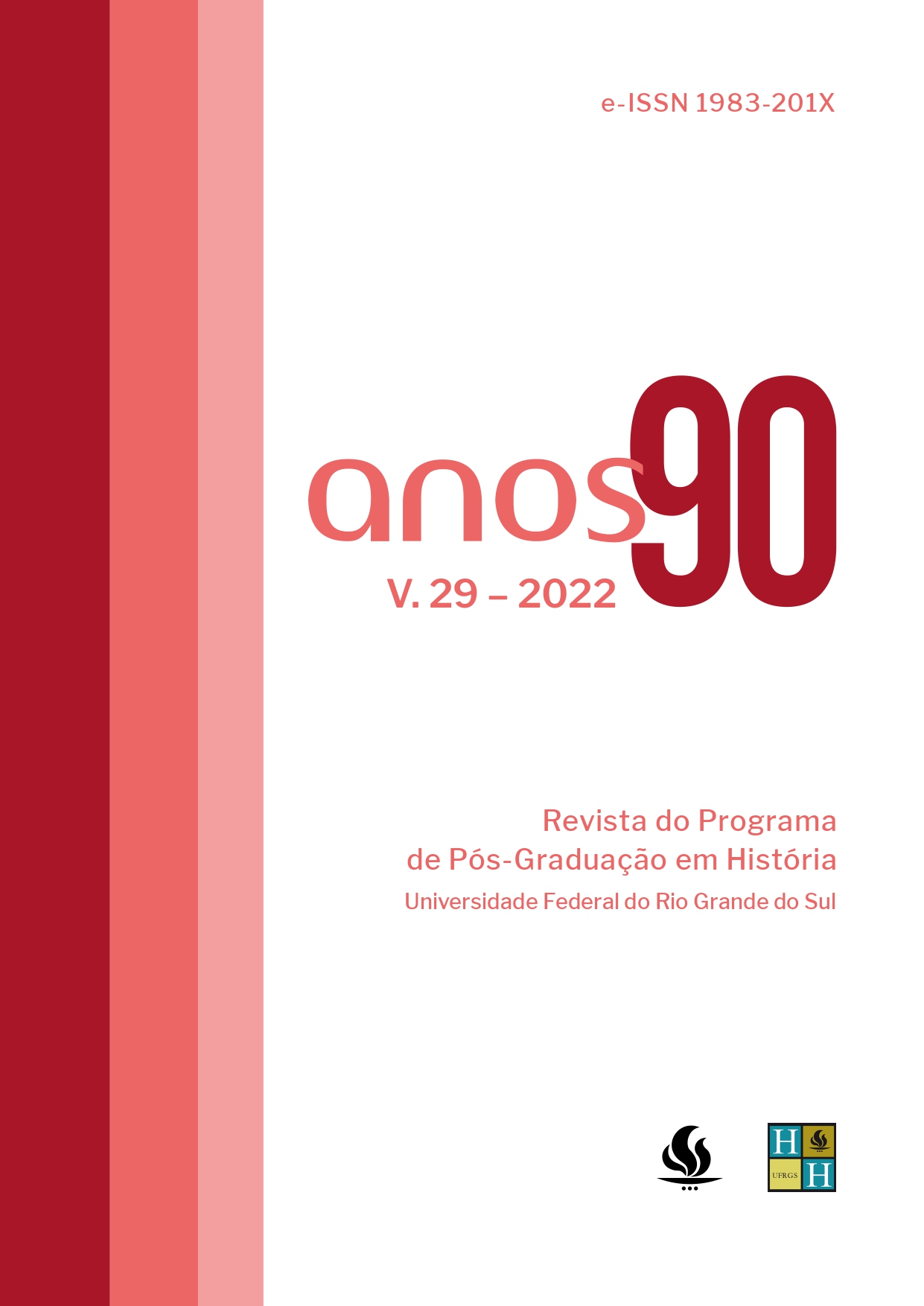Catharine Macaulay and the Roman matron: republicanism and uses of the past in Georgian England
DOI:
https://doi.org/10.22456/1983-201X.106803Keywords:
História da Historiografia britânica, Catharine Macaulay, Republicanismo, Usos do passado.Abstract
Between the 1760s and 1780s, the historian Catharine Macaulay carried out a Republican reading of English history in her books, while at the same time being linked in an image to the Roman matron through some public portraits. In this scenario, the Roman Republic is rescued as a source of inspiration for a present that needs again to be able to separate the virtues from the vices in the political arena. In this article I argue that Macaulay used a set of portraits published in the History of England editions, in the History of England in a series of letters or sold in bookstores, as an additional element to merge her with the principles of republicanism, the Roman Republic and the defense of freedom. Recognizing the validity, but also the limitations of the language of the Roman matron for the interpretation of these engravings, I propose that the pictorial narrative assembled by Macaulay seeks to recount the development of her connection with classical Roman republicanism, which
begins in her youth, blossoms throughout her life, and culminates in his historical persona fully realized in the History of England
Downloads
References
AYRES, Philip. Classical Culture and the Idea of Rome in Eighteenth-Century England. Cambridge: Cambridge University Press, 1999.
BARCHAS, Janine. Graphic Design, Print Culture, and the Eighteenth-Century Novel. Cambridge: Cambridge University Press, 2003.
COFFEE, Alan. Women and the History of Republicanism. Australasian Philosophical Review, v. 3, p. 1-15, 2020.
COLLEY, Linda. Women of the Republic: Intellect and Ideology in Revolutionary America. The University of North Carolina Press, 1980.
DAVIES, Kate. Catharine Macaulay and Mercy Otis Warren: The Revolutionary Atlantic and the Politics of Gender. New York: Oxford University Press. 2005.
DAVIS, Natalie Zemon. History's Two Bodies. The American Historical Review, v. 93, n. 1, p. 1-30, Feb. 1988.
EDMONDSON, Jonathan. Public Dress and Social Control in Late Republican and Early Imperial Rome. In: EDMONDSON, Jonathan; KEITH, Alison (ed.). Roman Dress and the Fabrics of Roman Culture. Toronto: University of Toronto Press, 2008. p. 21-46.
EGER, Elizabeth (ed.). Bluestockings displayed: portraiture, performance and patronage, 1730–1830. Cambridge: Cambridge University Press, 2013.
EGER, Elizabeth; PELTZ, Lucy. Brilliant Women: 18th-Century Bluestockings. Yale: Yale University Press, 2008.
FOX, Claire Gilbride. Catharine Macaulay, an Eighteenth-Century Clio. Winterthur Portfolio, v. 4, p. 129-142, 1968.
GREEN, Karen. The Correspondence of Catharine Macaulay. Oxford: Oxford University Press, 2019.
GREEN, Karen. Will the Real Enlightenment Historian Please Stand Up? Catharine Macaulay versus David Hume. In: TAYLOR, Craig; BUCKLE, Stephen. Hume and the Enlightenment. London: Pickering & Chatto, 2011. p. 39-52.
GUEST, Harriet. Small Change: Women, Learning, Patriotism, 1750-1810. Chicago: University of Chicago Press, 2000.
GUEST, Harriet. Bluestocking Feminism. Huntington Library Quarterly, v. 65, n. 1/2, Reconsidering the Bluestockings, p. 59-80, 2002.
HICKS, P. Catharine Macaulay's Civil War: Gender, History, and Republicanism in Georgian Britain. Journal of British Studies, v. 41, n. 2, p. 170-198, 2002.
HICKS, Philip. The Roman Matron in Britain: Female Political Influence and Republican Response, ca. 1750–1800. The Journal of Modern History, v. 77, p. 35-69, March 2005.
KERBER, Linda K. The Republican Mother: Women and the Enlightenment—an American Perspective, American Quarterly, v. 28, n. 2, 187-205, 1976.
LINDNER, Molly. Portraits of the Vestal Virgins, Priestesses of Ancient Rome. Michigan: University of Michigan Press, 2015.
LOOSER, Devoney. Catharine Macaulay: The ‘Female Historian’ in Context, Études Épistémè [En ligne], v. 17, 2010.
MACAULAY, Catharine. Loose Remarks on Certain Positions to be found in Mr. Hobbes's Philosophical Rudiments of Government and Society. London: T. Davis, Robinson and Roberts and T. Cadell, 1767.
MAZZUCCO‐THAN, Cecile. “As easy as a chimney pot to blacken”: Catharine Macaulay “the celebrated female historian”. Prose Studies: History, Theory, Criticism, v. 18, n. 3, p. 78-104, 1995.
MCCREERY, Cindy. The Satirical Gaze: Prints of Women in Late Eighteenth-century England. New York: Oxford University Press, 2004.
Memoirs of Mrs. Macaulay. The London Magazine, July, 1700.
OLSON, Kelly. Dress and the Roman Woman: self-presentation and Society. London and New York: Routledge, 2008.
PHILP, Mark. English Republicanism in the 1790s. The Journal of Political Philosophy, v. 6, n. 3, p. 235-262, 1998.
POCOCK, J. G. A. Catharine Macaulay: Patriot Historian. In: SMITH, Hilda L. (ed.). Women Writers and the Early Modern British Political Tradition. Cambridge: Cambridge University Press, 1998.
RICHARD, Carl J. The Founders and the Classics: Greece, Rome, and the American Enlightenment. Harvard: Harvard University Press, 1994.
SEBESTA, Juditla Lynn. Symbolism in the Costume of the Roman Woman. In: SEBESTA, Judith Lynn; TEH, Larissa Bonfante (ed.). The World of Roman Costume. Wisconsin: University of Wisconsin Press, 2001. p. 46-53.
SHEPHERD, Lynn B. Samuel Richardson and eighteenth-century portraiture. Thesis (Ph.D.) University of Oxford, 2006.
SHERRY, Suzanna. The Intellectual Origins of the Constitution: A Lawyers' Guide to Contemporary Historical Scholarship, Constitutional Commentary, 1988.
WINTERER, Caroline. The Mirror of Antiquity: American Women and the Classical Tradition, 1750–1900. Cornell University Press, 2007.
WITHEY, Lynne E. Catharine Macaulay and the Uses of History: Ancient Rights, Perfectionism, and Propaganda. Journal of British Studies, v. 16, n. 1, p. 59-83, Autumn 1976.



